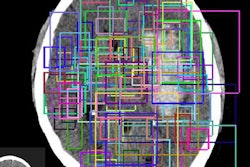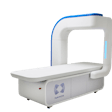
NATIONAL HARBOR, MD - Artificial intelligence (AI) technology shows considerable potential for aiding radiology's transition to value-based payment models, but these algorithms must yield quantifiable benefits to find a niche, according to presentations on May 30 at the Spring 2018 Data Science Summit.
To succeed in this new era, AI algorithms must help radiology practices show measurable improvements in quality and/or cost, said Dr. Gregory Nicola, chair of the American College of Radiology's (ACR) committee on the Medicare Access and CHIP Reauthorization Act (MACRA).
"[As a vendor], if your algorithm is not improving our population's health and reducing the cost of care, or at the very least keeping the cost of care the same, I think you're going to probably find very little traction for it in the end," he said. "This is not the fee-for-service environment where a PET scanner can be confused for a dryer or dishwasher and somebody would buy it. We're not in that market anymore."
He discussed the role of and challenges for AI in value-based payment paradigms at the summit, which was held by the ACR Data Science Institute and the Society for Imaging Informatics in Medicine (SIIM) in advance of SIIM's annual meeting this week.
A radically different paradigm
Although they have various iterations, value-based payments models are radically different than fee-for-service models and have different implications for the adoption of AI in radiology, Nicola said. There are two universal aspects to both approaches, though.
"Whoever makes the AI technology needs to be paid, or you're not going to make the technology," Nicola said. "Whoever buys the technology to treat patients has to get paid, or they're not going to buy the technology."
The models differ, however, in who starts the payments. In fee-for-service environments, it's the patient or his or her insurance company. That's not the case under value-based payments.
Negative consequences
The fee-for-service model has had its share of detractors. Nicola noted that there are absolute, negative consequences of paying everyone for every service they provide to patients.
For example, health data from the Organization for Economic Co-Operation and Development (OECD) show that the number of advanced imaging scanners and the number of scans performed on patients in the U.S. are roughly twice the OECD average -- with little change in outcomes, he said.
"And this is probably in part because of the fee-for-service system," Nicola said. "It has allowed lots of people to buy this technology, lots of vendors to make this technology, and plenty of patients and insurance companies to pay for it because of the methodology. This has led to high-cost healthcare with little outcomes. That means there's a lot of waste in our system, and a lot of it is overutilization of healthcare resources."
Gradual transition
The passage of MACRA in 2015 advanced the concept of value-based reimbursement by establishing the Medicare Quality Payment Program (QPP). There are now two different payment paradigms: the Merit-Based Incentive Payment System (MIPS) -- a fee-for-service payment system with value measurements that increase or decrease payment rates -- or some type of Alternative Payment Model (APM) pathway that has even heavier ties to value, Nicola said.
"Let's be straight: How we do on these performance programs and how you measure on value is how you will be reimbursed," he said. "It's reimbursed for your effort, it's reimbursed through incentives, and you can also get a negative penalty for not performing well. But there's extra money for performing well."
Commercial payors are also looking to transition to various gradations of value-based models, including accountable care organizations and even ultimately to population-based payments.
"You really need to figure out how you get paid for value -- what's in that value measurement and what kind of money is available for me," he said.
AI opportunities
Nicola said that three broad categories of radiology AI technology show particular promise in a value-based paradigm:
- Software that enables clear, clinical efficiencies in radiology practices, avoiding the need to add more staff or use more resources
- Software that can efficiently and cost-effectively guide the care pathway for acute-care patients by cutting out unnecessary use of resources such as, for example, follow-up chest CTs for every lung nodule. Also, software that can improve the classification of patients can save money by avoiding unnecessary biopsies or surgeries that previously would have been performed.
- Software that uses analytics to predict disease, enabling an earlier intervention that avoids the use of long-term care resources.
Importantly, vendors should develop performance measures around their AI application that promote how it can optimize quality or reduce cost -- or even better, optimize quality and reduce cost at the same time, according to Nicola.
"[What] you cannot do is have a product that reduces quality or increases cost," he said. "Or it will not fit into any kind of quality payment model."
Specific examples
Nicola highlighted some specific examples where AI could help in a value-based model, such as using imaging findings to avoid unnecessary breast biopsies.
"If you could increase the number of cancers you detect via biopsy and decrease the number of biopsies for benign disease, you would actually optimize the radiologist's quality score, leading to higher scores inside the QPP and a higher reimbursement," he said.
Similarly, an algorithm that could reduce false positives and false negatives on CT colonography would therefore decrease the number of subsequent colonoscopy procedures that are performed -- saving money. This would also improve the radiologist's quality score and payment bonus, he said.
A machine-learning algorithm could also enable more consistency in Thyroid Imaging Reporting and Data System (TI-RADS) classification of thyroid nodules found on ultrasound studies, he added. However, software that merely detects small lung nodules -- but doesn't characterize or assess risk -- would not provide much value to the healthcare system.




















